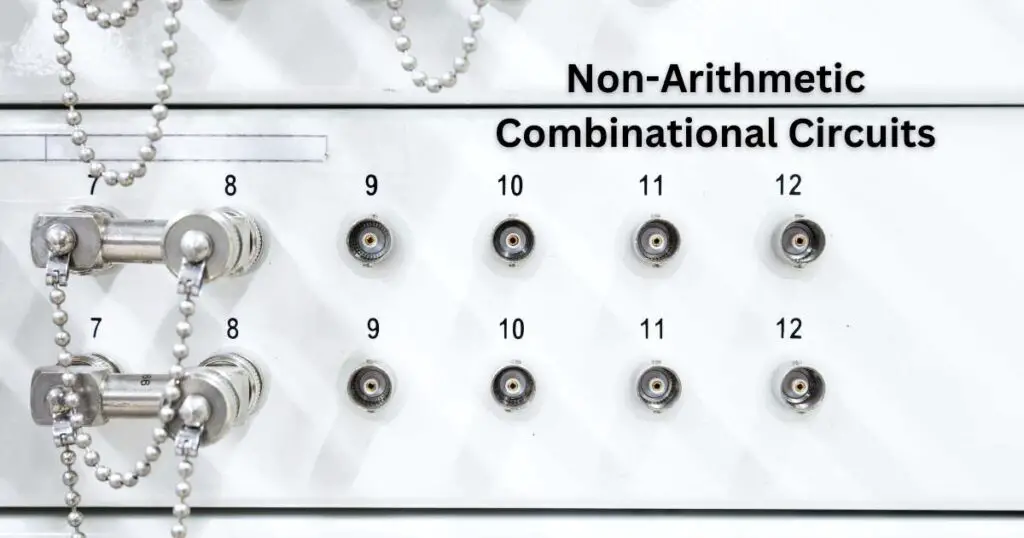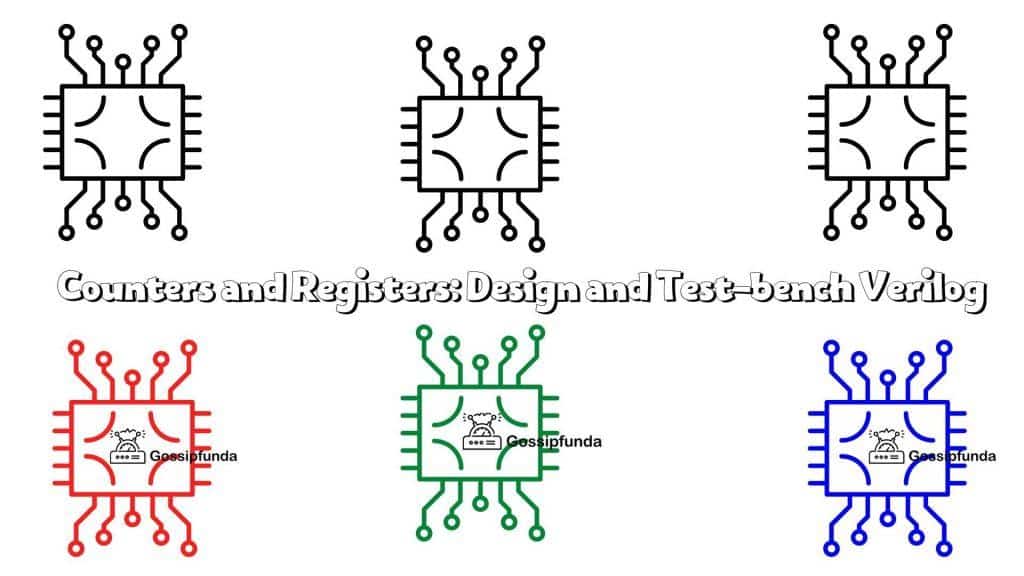In the realm of digital electronics, Non-Arithmetic Combinational Circuits are the unsung heroes that power a multitude of applications. From data routing and memory management to waveform generation and character displays, these circuits are foundational to designing efficient and reliable digital systems. Whether you’re a student delving into electronics, a hobbyist tinkering with circuits, or a professional engineer, understanding these combinational circuits is crucial. This updated guide explores the most widely used non-arithmetic combinational circuits, their functionalities, practical applications, and the latest advancements in the field.
Understanding Non-Arithmetic Combinational Circuits
Non-Arithmetic Combinational Circuits are digital circuits where the output is a pure function of the current inputs, without any reliance on past inputs or storage elements. Unlike arithmetic circuits that perform mathematical operations like addition and subtraction, non-arithmetic circuits handle tasks such as data selection, encoding, decoding, and signal distribution. These circuits are integral to various digital systems, enabling seamless data flow and control.
Key Characteristics
- Combinational Logic: Outputs depend solely on the current inputs.
- No Memory Elements: They do not store any previous states or data.
- Speed: Typically faster than sequential circuits due to the absence of feedback loops.
- Reliability: Predictable behavior as outputs are directly determined by inputs.
Essential Non-Arithmetic Combinational Circuits
Let’s delve into some of the most fundamental non-arithmetic combinational circuits, exploring their structures, functionalities, and applications.
1. Multiplexer (Mux)
Multiplexers, often referred to as Muxes, are versatile circuits that select one of many input signals and forward the selected input to a single output line. They play a crucial role in data routing within digital systems, enabling efficient management of multiple data streams.
Other names for Multiplexers include:
- Data Selector
- Many-to-One Circuit
- Parallel-to-Serial Converter
For example, a 2-to-1 Multiplexer has two data inputs, one select line, and one output. Depending on the select line’s value, it routes either input I0 or I1 to the output Y.

2. Demultiplexer (Demux)
Demultiplexers perform the opposite function of multiplexers. They take a single input signal and route it to one of many output lines based on select line values. Demuxes are essential for data distribution in digital systems, ensuring that signals are directed appropriately.
Alternate names include:
- Data Distributor
- Serial-to-Parallel Converter
- One-to-Many Circuit
For instance, a 1-to-8 Demultiplexer takes one input, three select lines, and routes the input to one of eight output lines.
3. Encoder
Encoders convert multiple input lines into a smaller number of output lines, typically in binary form. They are the reverse of decoders and are vital in applications like keyboard encoding, where multiple keys are translated into binary signals.
Common types include:
- 8-to-3 Line Encoder (Octal to Binary)
- 10-to-4 Line Encoder (Decimal to BCD)
- 16-to-4 Line Encoder (Hexadecimal to Binary)
For example, an 8-to-3 Encoder has eight input lines and three output lines. Each active input is encoded into a 3-bit binary code.

4. Decoder
Decoders convert binary information from ‘n’ input lines to a maximum of ‘2^n’ unique output lines. Only one output line is active for each combination of input signals, making decoders essential for applications like memory addressing and display decoding.
Popular types include:
- Binary-to-Octal (3-to-8 Line Decoders)
- Binary-to-Hexadecimal (4-to-16 Line Decoders)
- BCD-to-Decimal (4-to-10 Line Decoders)
For example, a 2-to-4 Decoder has two input lines and four output lines. Each unique input combination activates a specific output.
5. Hazard-Free Design
Hazards in digital circuits are unintended transient changes in output that can cause malfunctioning. They occur due to different propagation delays in various paths within a circuit, leading to temporary glitches or false spikes. Understanding and mitigating hazards is crucial for ensuring reliable circuit operation.
Types of Hazards:
- Static Hazards: Occur when a single output changes unexpectedly due to varying delays.
- Dynamic Hazards: Involve multiple unintended transitions in the output during a single input change.
- Essential Hazards: Inherent to the circuit’s structure and require careful design to mitigate.
To eliminate hazards, designers often add redundant gates or balance the propagation delays within the circuit.
Implementing Non-Arithmetic Combinational Circuits with Verilog
Verilog is a powerful hardware description language used to model digital systems. Below are examples of how to implement various non-arithmetic combinational circuits using Verilog.
Multiplexer (2-to-1 Mux) Implementation
Here’s a simple Verilog module for a 2-to-1 Mux:
module mux2_1(output c, input a, b, s);
assign c = s ? b : a;
endmodule
Alternatively, using gate-level modeling:
module mux2_1(output c, input a, b, s);
wire s1, x1, x2;
not (s1, s);
and (x1, a, s1);
and (x2, b, s);
or (c, x1, x2);
endmodule

Demultiplexer (1-to-8 Demux) Implementation
A Verilog module for a 1-to-8 Demux:
module Demultiplexer(
input in,
input s0, s1, s2,
output d0, d1, d2, d3, d4, d5, d6, d7
);
assign d0 = in & ~s2 & ~s1 & ~s0;
assign d1 = in & ~s2 & ~s1 & s0;
assign d2 = in & ~s2 & s1 & ~s0;
assign d3 = in & ~s2 & s1 & s0;
assign d4 = in & s2 & ~s1 & ~s0;
assign d5 = in & s2 & ~s1 & s0;
assign d6 = in & s2 & s1 & ~s0;
assign d7 = in & s2 & s1 & s0;
endmodule
Encoder (8-to-3 Encoder) Implementation
Verilog code for an 8-to-3 Encoder:
module Encoder(
input d0, d1, d2, d3, d4, d5, d6, d7,
output a, b, c
);
assign a = d4 | d5 | d6 | d7;
assign b = d2 | d3 | d6 | d7;
assign c = d1 | d3 | d5 | d7;
endmodule
Decoder (2-to-4 Decoder) Implementation
Verilog code for a 2-to-4 Decoder:
module Decoder(
input a, b,
output d0, d1, d2, d3
);
assign d0 = ~a & ~b;
assign d1 = ~a & b;
assign d2 = a & ~b;
assign d3 = a & b;
endmodule
Practical Applications of Non-Arithmetic Combinational Circuits
Non-Arithmetic Combinational Circuits are ubiquitous in various digital systems. Here are some real-life applications that highlight their significance:
1. Data Routing and Selection
Multiplexers are extensively used in data routing within CPUs and communication systems. They enable the selection of data from multiple sources, directing it to the desired output channel efficiently.
2. Memory Address Decoding
Decoders play a vital role in memory systems by translating binary addresses into specific memory locations. This ensures accurate data retrieval and storage within RAM modules.
3. Keyboard Encoding
Encoders are used in keyboards to convert multiple key presses into binary codes that the computer can process. Each key corresponds to a unique binary code, facilitating seamless communication between the keyboard and the computer.
4. Display Control
Decoders are integral to display systems, especially in 7-segment displays used in digital clocks, calculators, and other electronic devices. They convert binary inputs into signals that light up the appropriate segments to display numbers and characters.
Latest Advancements and Trends
The field of digital electronics is continuously evolving, with advancements that enhance the performance and capabilities of non-arithmetic combinational circuits. Here are some of the latest trends:
1. Low-Power Design
With the increasing demand for energy-efficient devices, designing low-power combinational circuits has become a priority. Techniques such as gate-level optimization and power gating are employed to reduce power consumption without compromising performance.
2. Integration with FPGA and ASIC
Field-Programmable Gate Arrays (FPGA) and Application-Specific Integrated Circuits (ASIC) have revolutionized the implementation of combinational circuits. These platforms allow for rapid prototyping and customization, enabling designers to create highly optimized and scalable circuits tailored to specific applications.
3. Enhanced Testing and Verification
Advanced testing methodologies and verification tools ensure the reliability and correctness of combinational circuits. Automated testing frameworks and simulation tools like Verilog and VHDL are pivotal in identifying and rectifying design flaws early in the development process.
4. High-Speed Data Processing
The push for faster data processing has led to the development of high-speed combinational circuits. Innovations in transistor technology and circuit design have enabled circuits to handle larger data volumes at unprecedented speeds, catering to the needs of modern computing and communication systems.
Real-Life Example: Designing a 4-to-1 Multiplexer
To illustrate the practical application of a 4-to-1 Multiplexer, let’s walk through its design and implementation using Verilog.
Step-by-Step Guide
- Define the Module: Start by defining the inputs and outputs of the Mux.
- Implement the Selection Logic: Use internal wires to manage the selection process.
- Instantiate Sub-Muxes: Break down the 4-to-1 Mux into smaller 2-to-1 Muxes for easier implementation.
- Simulate and Test: Create a test bench to verify the functionality of the Mux under various input conditions.
Here’s the Verilog code for a 4-to-1 Multiplexer:
module mux4_1(output y, input x1, x2, x3, x4, z1, z2);
wire w1, w2;
mux2_1 m1(w1, x1, x2, z1);
mux2_1 m2(w2, x3, x4, z1);
mux2_1 m3(y, w1, w2, z2);
endmodule
module mux2_1(output c, input a, b, s);
wire s1, x1, x2;
assign s1 = ~s;
and (x1, a, s1);
and (x2, b, s);
or (c, x1, x2);
endmodule
And the corresponding test bench:
module mux4_1tb;
wire y;
reg x1, x2, x3, x4, z1, z2;
mux4_1 dut(y, x1, x2, x3, x4, z1, z2);
initial begin
$monitor("y=%b, x1=%b, x2=%b, x3=%b, x4=%b, z1=%b, z2=%b", y, x1, x2, x3, x4, z1, z2);
$dumpfile("mux4_1tb.vcd");
$dumpvars;
// Test cases
x1 = 0; x2 = 0; x3 = 1; x4 = 1; z1 = 0; z2 = 1; #50;
x1 = 0; x2 = 1; x3 = 0; x4 = 1; z1 = 0; z2 = 0; #50;
x1 = 1; x2 = 0; x3 = 1; x4 = 0; z1 = 1; z2 = 0; #50;
x1 = 1; x2 = 1; x3 = 0; x4 = 0; z1 = 1; z2 = 1; #50;
end
endmodule
Potential Risks and Considerations
While designing and implementing non-arithmetic combinational circuits, it’s essential to be aware of potential risks and considerations:
- Propagation Delays: Variations in signal propagation can lead to timing issues, especially in high-speed circuits.
- Power Consumption: Complex combinational circuits can consume significant power, necessitating efficient design practices.
- Circuit Complexity: As circuits scale, managing complexity becomes challenging, requiring meticulous planning and verification.
- Fault Tolerance: Ensuring that circuits can handle faults gracefully is crucial for maintaining system reliability.
Implementing thorough testing and simulation during the design phase can mitigate these risks, ensuring robust and efficient circuit performance.
Conclusion
Non-Arithmetic Combinational Circuits are indispensable components in the landscape of digital electronics. From multiplexers and demultiplexers to encoders and decoders, these circuits facilitate critical functions like data routing, encoding, and signal distribution. Understanding their design, implementation, and applications equips you with the knowledge to craft efficient and reliable digital systems.
As technology advances, so do the capabilities and complexities of combinational circuits. Embracing the latest trends, such as low-power design and integration with FPGA and ASIC, can enhance your circuit designs, making them more efficient and scalable. Additionally, leveraging hardware description languages like Verilog enables precise modeling and simulation, ensuring your circuits perform as intended.
Whether you’re a student, hobbyist, or professional, mastering Non-Arithmetic Combinational Circuits opens doors to innovative digital designs and solutions. Stay curious, keep experimenting, and explore the ever-evolving world of digital electronics to stay ahead of the curve.
Don’t Miss Our Previous Blogs:
- Introduction to VLSI
- Modeling Basic Gates through Verilog
- Modeling of Universal and Special Gates on Verilog
- Designing Combinational Circuits through Verilog HDL
I am an electronics and communication graduate. I qualified GATE in the same domain in 2019. Due to the appetite for VLSI, I am going to join the Hong Kong University of Science and Technology for Masters in IC design this year. My interest in writing evoked during college time when I wrote technical essays for college fest. Apart from it, I am a part of a few local NGOs too.



Such a nice read! Amazing work!